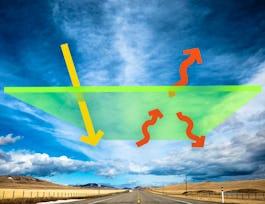This class provides a series of Python programming exercises intended to explore the use of numerical modeling in the Earth system and climate sciences. The scientific background for these models is presented in a companion class, Global Warming I: The Science and Modeling of Climate Change. This class assumes that you are new to Python programming (and this is indeed a great way to learn Python!), but that you will be able to pick up an elementary knowledge of Python syntax from another class or from on-line tutorials.

Global Warming II: Create Your Own Models in Python
Taught in English
15,534 already enrolled
(52 reviews)
Details to know

Add to your LinkedIn profile
6 quizzes
See how employees at top companies are mastering in-demand skills


Earn a career certificate
Add this credential to your LinkedIn profile, resume, or CV
Share it on social media and in your performance review

There are 5 modules in this course
This class is intended to complement a Coursera class called Global Warming I: The Science and Modeling of Climate Change, which presents much of the background to the material here. In this class you'll be using spreadsheets (maybe) and Python (definitely) to do some simple numerical calculations on topics in Earth System Science. The model you'll be working on this week is based on material from Unit 3 of that class, called First Climate Model.
What's included
2 videos6 readings1 quiz1 programming assignment1 peer review
The ideas behind this model were explained in Unit 7, Feedbacks, in Part I of this class. First we get to generate simple linear "parameterization" functions of planetary albedo and the latitude to which ice forms (colder = lower latitude ice). Second, for any given value of the solar constant, L, we'll use iteration to find consistent values of albedo and T, to show the effect of the ice albedo feedback on Earth's temperature, running away to fall into the dreaded "snowball Earth".
What's included
1 video3 readings1 quiz1 programming assignment1 peer review
Ice flows like extra-thick molasses, downhill. The shape of the ice sheet (altitude versus distance across) is determined by the relationship between ice surface slope and the flow rate of the ice.
What's included
1 video3 readings1 quiz1 programming assignment1 peer review
Planetary rotation and fluid flow were explained in Part I of this class, Unit 6, on Weather and Climate.
What's included
1 video1 reading2 quizzes3 programming assignments1 peer review
Background for this model was presented in Part I of this class, Unit 9, The Perturbed Carbon Cycle.
What's included
1 video4 readings1 quiz1 programming assignment1 peer review
Instructor

Offered by
Recommended if you're interested in Environmental Science and Sustainability

The University of Chicago

Banco Interamericano de Desarrollo

Coursera Project Network

Universitat Autònoma de Barcelona
Why people choose Coursera for their career




Learner reviews
Showing 3 of 52
52 reviews
- 5 stars
53.84%
- 4 stars
21.15%
- 3 stars
13.46%
- 2 stars
3.84%
- 1 star
7.69%

Open new doors with Coursera Plus
Unlimited access to 7,000+ world-class courses, hands-on projects, and job-ready certificate programs - all included in your subscription
Advance your career with an online degree
Earn a degree from world-class universities - 100% online
Join over 3,400 global companies that choose Coursera for Business
Upskill your employees to excel in the digital economy
Frequently asked questions
Access to lectures and assignments depends on your type of enrollment. If you take a course in audit mode, you will be able to see most course materials for free. To access graded assignments and to earn a Certificate, you will need to purchase the Certificate experience, during or after your audit. If you don't see the audit option:
The course may not offer an audit option. You can try a Free Trial instead, or apply for Financial Aid.
The course may offer 'Full Course, No Certificate' instead. This option lets you see all course materials, submit required assessments, and get a final grade. This also means that you will not be able to purchase a Certificate experience.
When you purchase a Certificate you get access to all course materials, including graded assignments. Upon completing the course, your electronic Certificate will be added to your Accomplishments page - from there, you can print your Certificate or add it to your LinkedIn profile. If you only want to read and view the course content, you can audit the course for free.
You will be eligible for a full refund until two weeks after your payment date, or (for courses that have just launched) until two weeks after the first session of the course begins, whichever is later. You cannot receive a refund once you’ve earned a Course Certificate, even if you complete the course within the two-week refund period. See our full refund policy.
